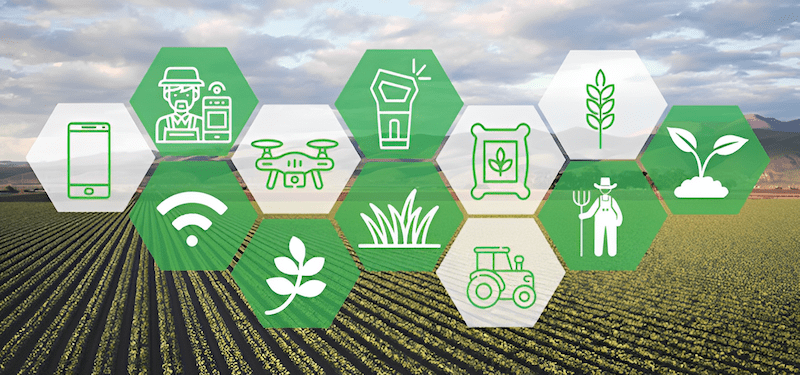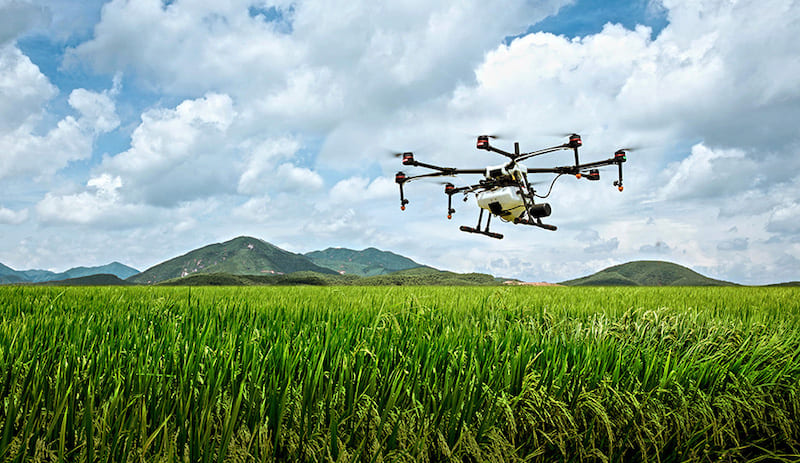
As the world’s population surges past 8 billion people, the pressures on supply chains and global food production are increasing exponentially. As a result, the challenges that lie ahead for all of us are almost insurmountable.
Beyond the obvious problem of overpopulation, other issues are affecting the production of food including water scarcity, loss of agricultural lands, soil degradation, and climate change.
A new approach to food production is emerging that shows much promise – precision farming.
Precision Farming brings together an array of advanced technologies that address by design, the various threats to food production that face the planet. Precision farming technologies streamline farming operations, save resources like soil water and fertilizer, cut waste, and drive productivity.
At the core of precision farming is data-driven insights that help farmers achieve a more sustainable model for food production.
Whether it's deploying drones to monitor crops, or using AI for predictive analysis, precision farming is redefining the sustainable agirculture space around the world. Precision Farming is not just the latest advancement; it's a revolution, destined to reshape how the world grows food.

As the center of Precision Farming is GPS, abbreviated for a Global Positioning System that is rapidly changing the agricultural landscape. GPS technology provides farmers with a highly accurate tool for monitoring all aspects of crop production in real-time from their cell phone.
GPS systems can provide farmers precise location data that may include identifying low and high-water marks in a field or create high-resolution digital map of their land. Digital mapping can help with cultivation, navigating farm equipment around the contours that may be present on a section of land.
Not only does GPS allow for detailed mapping of agricultural fields, but it also brings a level of operational visibility previously unimagined. It enables tracking of farming equipment such as cultivators, seeders, and harvesters in real-time, which in turn, contributes to better equipment management.
Throughout the entire process of cultivation, seedling, and harvesting GPS tracks and optimizes the use of resources including fuel. At present, farmers that employ GPS technology to manage their farm operations save an average of 10% on fuel and maintenance costs.
Another solution to the one-size-fits-all approach to traditional farming is Variable Rate Technology (VRT), allows farmers to tailor agricultural inputs based on the needs of different crops and soil zones.
Variable Rate Technology accurately evaluates soil types, moisture content, and nutrient levels, delivering a digital representation of current field conditions. Using this information, farmers can fine-tune the application of expensive inputs such as fertilizer, pesticides, and irrigation water. The result is a targeted resource application strategy that ensures each section of the field receives exactly what it needs for plants to thrive.
VRT also minimizes waste and ensures optimal utilization of resources thereby lowering costs. VRT also optimizes productivity, improves yields, and advances sustainability. It is a prime example of precision farming and deployment of responsive agricultural practices.
Fast becoming an essential tool in Precision Farming, remote sensing technologies like fixed wing drones or satellites silently observer, tirelessly collecting invaluable data from high above and never seen. These eyes in the sky collect data above and below the ground producing imagery that transcends the limitations of low altitude ground-level observations provided by helicopter drones and recreational balloons.
The capabilities of remote sensing extend far beyond their impressive data collection capabilities, they also provide farmers with an interactive real-time view of crop health and soil conditions, effectively acting as a check-and-balance mechanism for the entire field.
Furthermore, they can detect and track weather patterns, offering critical insight into the climatic factors that influence crop growth. Remote sensing technologies also have the capability to identify potential threats from pests or disease before they become visually apparent on the ground.
Using this technology, farmers can proactively manage their crops and strategically address issues on in the filed before they manifest.
A technological flock of drones, or Unmanned Aerial Vehicles (UAVs), have taken flight over our agricultural landscape. These autonomous devices, unassuming in their compact structures, quietly soar above fields, providing an unprecedented bird's eye view of the terrain.
The sophistication of these UAV’s drones extends well beyond their autonomous flight capabilities. Most are equipped with advanced cameras and sensors that provide farmers with high-resolution aerial imagery. This powerful visual data reveals the subtle undulations of the landscape, as well as the status of crops in a level of detail that ground-based observation can't match.
Drones excel at crop scouting, vigilantly identifying issues that may include pest infestations or nutrient deficiencies. Their monitoring capabilities also extend to irrigation systems, ensuring that water distribution is optimized across the field.
Besides observation, drones are also being use for seeding fields with cover crops like alfalfa and clover.

Geographical Information Systems (GIS) are often viewed as the geospatial mastermind of Precision Farming. GIS provides farmers with a means to visualize, scrutinize, and decode the multitude of data that characterizes their fields.
Geographical Information Systems are digital cartographers assisting in the creation of precise field maps for farmers. These maps serve as a visual guide to the topology and layout of the fields, crucial for planning, plowing, seeding, irrigating, managing, and harvesting farm fields.
Besides mapping, GIS contributes significantly to soil analysis by overlaying different data sets like soil composition, moisture levels, and nutrient content.
Furthermore, it acts as a vital aid in crop management, offering predictive models and trend analyses that help determine the best cultivation strategies.
GIS enhances decision-making, enabling farmers to manage their fields with precision and foresight. The integration of this geospatial intelligence is not just an improvement, but a leap forward in the advancement of sustainable farming practices.
The lifeblood of Precision Farming, sensor technology facilitates the continuous stream of data vital for effective, resource smart agriculture. These high-tech devices, ranging from soil moisture sensors to weather stations, and from crop health monitors to nutrient analyzers, act as the farmers' digital eyes and ears on the ground.
These sensors work tirelessly, measuring and monitoring an array of parameters hour-by-hour that influence the health and yield of crops.
Whether it's tracking soil moisture levels to save water used for irrigation or gauging ambient weather conditions to predict growth patterns, sensors provide a wealth of real-time data that can be used to save money and improve yield.
Similarly, crop health sensors scan plants for signs of stress, disease, or threat of pest invasion, allowing for swift action before either or all of these conditions escalate.
Through the constant feedback provided by sensor technology, Precision Farming doesn't just react to conditions, but anticipates and responds to change, optimizing agricultural productivity, and sustainability.
Agronomy, a branch of agricultural science, focuses on the theory and practice of crop production and field management. This discipline seeks to understand and enhance the interactions between plants, soils, and the environment to optimize crop yield and improve food and fiber production.
By studying factors such as soil health, irrigation, pest management, and crop rotation, agronomists develop sustainable farming practices and contribute valuable insights to the advancing field of Precision Farming. These professionals play an essential role in managing and mitigating agricultural challenges, improving food security, and promoting environmental sustainability.
Crop scouting, also known as field scouting, is an agricultural practice where farmers or trained agronomists regularly inspect fields to assess crop health and identify potential issues. This can include the detection of pests, diseases, nutrient deficiencies, and other factors that could negatively impact crop yields.
The process involves observing and recording data about the crops and their growing conditions, often using tools like GPS and remote sensing technologies. The insights gained from crop scouting allow farmers to make informed decisions about managing their crops, how to optimize productivity, and minimize losses.
Crop scouting can be performed more efficiently and accurately with the help of advanced technologies such as drones and sensor systems.
Smart Farming represents the next evolution in Precision Farming. It embraces the fusion of cutting-edge technologies such as Internet of Things (IoT) devices, artificial intelligence (AI), machine learning, and advanced analytics to propel agricultural practices into a new era.
At the heart of Smart Farming lies data — mountains of it. The technologies deployed collect, process, and analyze vast amounts of information in real-time, facilitating precise, data-driven decisions. These intelligent systems automate numerous processes, from irrigation scheduling to pest management, reducing manual labor and minimizing the risk of human error. In doing so, Smart Farming significantly enhances productivity, improves resource efficiency, and promotes sustainable agriculture. It exemplifies the intersection of agriculture and technology, paving the way for a new generation of farming where decision-making is grounded in data and enhanced through automation.
Precision Farming is revolutionizing agriculture by integrating technology into every step of the farming process. By harnessing the power of data and technology, farmers can make more informed decisions, optimize resource use, and enhance productivity, all while reducing their environmental footprint. It represents a significant leap forward in sustainable and efficient agricultural practices.